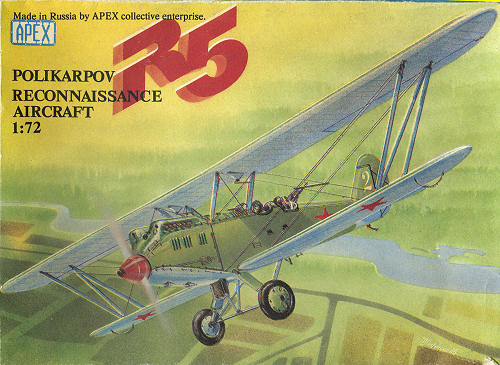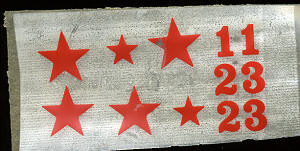
Apex 1/72 Polikarpov R-5
| KIT #: | ? |
| PRICE: | $6.98 for the one I bought |
| DECALS: | Three Options |
| REVIEWER: | Scott Van Aken |
| NOTES: | Treat it like short run. |

| HISTORY |
The R-5 was developed by the design bureau lead by Nikolai Nikolaevich Polikarpov as a replacement for the R-1, the copy of the Airco DH.9A which served as the standard reconnaissance and light bomber aircraft with the Soviet Air Force.
The prototype first flew in autumn 1928, powered by an imported German BMW VI V-12 engine. It was an unequal span single bay biplane of mainly wooden construction.
After extensive evaluation, the R-5 entered production in 1930, powered by Mikulin M-17s, a licence built copy of the BMW-VI, as a reconnaissance bomber. Further modified versions were produced to serve as floatplanes, ground attack aircraft and civil transports.
The R-5SSS, an improved reconnaissance bomber with improved streamlining, served as the basis for the Polikarpov R-Z, which succeeded the R-5 in production.
1,000 aircraft were manufactured for Aeroflot under the designation P-5. The aircraft was also taken into the Soviet Air Force's use in 1931. They operated 5,000 aircraft under the designation R-5.
The R-5 became the standard reconnaissance and attack aircraft with the Soviet Air Force, being used in large numbers, with over 100 regiments equipped with the R-5. R-5s served with the Soviet Air Force during the 1939 Battle of Khalkhin Gol, took active part in Soviet invasion of Poland (1939), fought against the Japanese and the 1939-40 Winter War against Finland, where they were known as the hermosaha ("nerve saw"). The Finns downed and captured several R-5s, but none were taken into operational service. They remained in service during the war against Germany in 1941-45, where they were mainly used as night bombers and liaison aircraft, serving until 1944.
R-5s were also used by the Spanish Republicans in the Spanish Civil War, 31 being sold to Spain. These arrived in November 1936, and were quickly deployed on combat operations, but were found to be slow and were relegated to night bombing. Seven R-5s remained in good condition in March 1939. The aircraft was known as the Natasha in the Republican Air Force.
Civil versions of the R-5 were used in large numbers, mainly with Aeroflot. They were used to carry up to 400 kg (882 lb) of freight, with many being fitted with an enlarged rear cockpit to carry two passengers. Other aircraft were fitted with enclosed cabins for passengers. P-5s could also be used to carry underwing containers capable of carrying underwing containers (or Kasseta) for freight or passengers with one P-5 carrying 16 adults, including seven in each Kasseta. Ski equipped P-5s carrying Kasseta paid a key role in the rescue of the crew of the ice bound Soviet steamship Chelyuskin in 1934. Civil R-5s remained in service until after the end of the Second World War.
| THE KIT |
 This is one of those kits that seems to find a home in a number of different boxes. Two white sprues with several parts having considerable flash greets one as the flimsy cardboard box is opened. Out falls a single sheet of dry transfers, a half sheet of paper with 'instructions' and that is about it.
This is one of those kits that seems to find a home in a number of different boxes. Two white sprues with several parts having considerable flash greets one as the flimsy cardboard box is opened. Out falls a single sheet of dry transfers, a half sheet of paper with 'instructions' and that is about it.
Though not really high tech, the kit is fairly well molded. The upper wing is a single piece, though obviously a triple casting as there is flash between the outer wing panels and the center section. Separate ailerons have some engraved detail on the upper surface and none at all on the under side. The kit also has a separate one-piece rudder, one-piece elevators and one-piece horizontal stabilizers. Oddly, the small fin is two parts.
Interior consists of a floor, seat and stick for the pilot while the rear gunner has a small floor section and his gun. An engine upper cowling is provided, but completely missing are any exhaust ports. Also absent are windscreens, but it appears from the drawing that one makes these from any stiff, clear sheet available. The struts seem well molded as do the landing gear legs. Small indentations in the wings and fuselage show where these struts attach. No rigging diagram is provided, though the box art looks to be adequate for the most part.
Instructions are, as mentioned, a half sheet of paper printed on one side. The lower half of this is an exploded diagram of the parts with two small detail drawings. One of them shows the installation of the non-existent exhaust piece whilt eh other shows the parts that make up the rear cockpit. One needs to study the drawing and box art as the instructions miss the attachment of the lower radiator and instrument panel completely. A set of what appear to be dry transfers is included that have basic insignia and three sets of numbers. No painting guide is provided.
| CONCLUSIONS |
Well, the purpose of this preview was to show that if one has little money to spend on a kit, a trip to your local hobby shop can produce something of interest to be built. Now you aren't going to get a Tamiya kit for under $10, but if you want something interesting that will definitely keep your building skills sharp, then something like this will fill the bill. If one doesn't want to do a basic green over light blue scheme, then a bit of web searching will show alternate markings possibilities.
| REFERENCES |
http://en.wikipedia.org November 2008 If you would like your product reviewed fairly and fairly quickly, please contact the editor or see other details in the